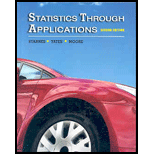
Concept explainers
a)
To identify whether the observational study or experimental study.
a)
Answer to Problem 1.35E
This is an experimental study.
Explanation of Solution
Given:
A psychologist carried out a study with about 100 third-graders that was designed to help answer this question. In the study, the children were divided into two groups and instructed to make a "silly" collage using materials that were provided. Before they started, the children in one group were told that their collages would be judged by experts and that the winners would receive prizes. The children in the other group were told that they would share their collages in an art party. In fact, expert judges rated the creativity of all the collages.
First need to understand about the experimental study and observational study:
Experimental study: Assigning people or things to groups and applying some treatment to one group, while the other group does not receive the treatment.
Observation study: In an observational study, measure or survey members of a sample without trying to affect them.
This study is an experimental study. In this study, there are two groups in which one group having a treatment which is the proof that it is experimental study.
b)
To explain the importance that judges were not aware of which students' collages came from which group.
b)
Answer to Problem 1.35E
To avoid biasness in the study.
Explanation of Solution
Given:
A psychologist carried out a study with about 100 third-graders that was designed to help answer this question. In the study, the children were divided into two groups and instructed to make a "silly" collage using materials that were provided. Before they started, the children in one group were told that their collages would be judged by experts and that the winners would receive prizes. The children in the other group were told that they would share their collages in an art party. In fact, expert judges rated the creativity of all the collages.
If judges know which students in the college came from which group then there are chances that result will be bias. Therefore, to avoid this biasness it is important that judges should not aware of which students' collages came from which group.
c)
To explaintwo possible sources of variation in this study.
c)
Explanation of Solution
Given:
A psychologist carried out a study with about 100 third-graders that was designed to help answer this question. In the study, the children were divided into two groups and instructed to make a "silly" collage using materials that were provided. Before they started, the children in one group were told that their collages would be judged by experts and that the winners would receive prizes. The children in the other group were told that they would share their collages in an art party. In fact, expert judges rated the creativity of all the collages.
There might be many source variations. One source of variation could have been that the third-graders had varying levels of skill with art, resulting in discrepancies between the quality of the collages. Another source of variation that the third-graders' access to materials could have been different.
d)
To explain whether we conclude that the difference in creativity scores was caused by the difference in what the two groups of children were told.
d)
Explanation of Solution
Given:
A psychologist carried out a study with about 100 third-graders that was designed to help answer this question. In the study, the children were divided into two groups and instructed to make a "silly" collage using materials that were provided. Before they started, the children in one group were told that their collages would be judged by experts and that the winners would receive prizes. The children in the other group were told that they would share their collages in an art party. In fact, expert judges rated the creativity of all the collages.
There might be many other reasons which caused to conclude that the difference in creativity score. It is called confounding variables. Hence, it cannot conclude as there may have confounding variables.
Chapter 1 Solutions
Statistics Through Applications
Additional Math Textbook Solutions
Essentials of Statistics, Books a la Carte Edition (5th Edition)
Intro Stats, Books a la Carte Edition (5th Edition)
Elementary Statistics Using Excel (6th Edition)
STATS:DATA+MODELS-W/DVD
Fundamentals of Statistics (5th Edition)
Introductory Statistics (10th Edition)
 MATLAB: An Introduction with ApplicationsStatisticsISBN:9781119256830Author:Amos GilatPublisher:John Wiley & Sons Inc
MATLAB: An Introduction with ApplicationsStatisticsISBN:9781119256830Author:Amos GilatPublisher:John Wiley & Sons Inc Probability and Statistics for Engineering and th...StatisticsISBN:9781305251809Author:Jay L. DevorePublisher:Cengage Learning
Probability and Statistics for Engineering and th...StatisticsISBN:9781305251809Author:Jay L. DevorePublisher:Cengage Learning Statistics for The Behavioral Sciences (MindTap C...StatisticsISBN:9781305504912Author:Frederick J Gravetter, Larry B. WallnauPublisher:Cengage Learning
Statistics for The Behavioral Sciences (MindTap C...StatisticsISBN:9781305504912Author:Frederick J Gravetter, Larry B. WallnauPublisher:Cengage Learning Elementary Statistics: Picturing the World (7th E...StatisticsISBN:9780134683416Author:Ron Larson, Betsy FarberPublisher:PEARSON
Elementary Statistics: Picturing the World (7th E...StatisticsISBN:9780134683416Author:Ron Larson, Betsy FarberPublisher:PEARSON The Basic Practice of StatisticsStatisticsISBN:9781319042578Author:David S. Moore, William I. Notz, Michael A. FlignerPublisher:W. H. Freeman
The Basic Practice of StatisticsStatisticsISBN:9781319042578Author:David S. Moore, William I. Notz, Michael A. FlignerPublisher:W. H. Freeman Introduction to the Practice of StatisticsStatisticsISBN:9781319013387Author:David S. Moore, George P. McCabe, Bruce A. CraigPublisher:W. H. Freeman
Introduction to the Practice of StatisticsStatisticsISBN:9781319013387Author:David S. Moore, George P. McCabe, Bruce A. CraigPublisher:W. H. Freeman





